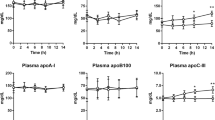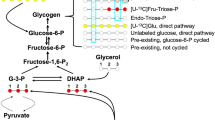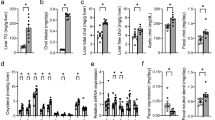Abstract
FATTY acids concerned with supplying the caloric requirements of the body are transported in the blood primarily as free fatty acids (FFA) or as triglyceride fatty acids (TGFA). The liver is thought to play a central part in the metabolism of both chemical forms1. Investigations have shown that injected FFA labelled with carbon-14 are taken up by the liver2, where they may be catabolized by β-oxidation to carbon dioxide or ketone bodies3, or be synthesized into TGFA, which give rise to the very-low-density (d < 1.006) lipoproteins of the plasma2. Chylomicron-TGFA labelled with carbon-14 are also reported to be taken up by the liver4 and to be oxidized to carbon dioxide or ketone bodies in certain experimental conditions3. However, previous experiments in vivo have demonstrated that the magnitude of ketogenesis in fat-fed rats is not related to the extent of the influx of chylomicrons5 but rather to the level of circulating FFA6. In perfused livers from fasted rats, Morris3 found that 75 per cent of chylomicron-TGFA were removed from the perfusate and more than 20 per cent oxidized to carbon dioxide and ketone bodies in 4 h. Similarly, Rodbell et al.7 reported 25 per cent uptake and 2 per cent oxidation of a triglyceride emulsion in 2 h. As these authors used heparin (a known activator of lipoprotein lipase) in their standard preparations, the extent to which hydrolysis of the infused TGFA to FFA was responsible for these significant rates of uptake and oxidation remains unknown.
This is a preview of subscription content, access via your institution
Access options
Subscribe to this journal
Receive 51 print issues and online access
$199.00 per year
only $3.90 per issue
Buy this article
- Purchase on Springer Link
- Instant access to full article PDF
Prices may be subject to local taxes which are calculated during checkout
Similar content being viewed by others
References
Favarger, P., in The Liver, edit. by Rouiller, C., 1, 549 (Academic Press, New York, 1963).
Havel, R. J., Felts, J. M., and Van Duyne, C. M., J. Lipid Res., 3, 297 (1962).
Morris, B., J. Physiol., 168, 564 (1963).
Bragdon, J. H., and Gordon, jun., R. S., J. Clin. Invest., 37, 574 (1958).
Mayes, P. A., Metabolism, 11, 781 (1962).
Mayes, P. A. (unpublished results).
Rodbell, M., Scow, R. O., and Chernick, S. S., J. Biol. Chem., 239, 385 (1964).
Miller, L. L., Bly, C. G., Watson, M. L., and Bale, W. F., J. Exp. Med., 94, 431 (1951).
Fredrickson, D. S., Ono, K., and Davis, L. L., J. Lipid Res., 4, 24 (1963).
Felts, J. M., in Fat as a Tissue, edit. by Rodahl, K. (McGraw-Hill, New York, 1964).
Havel, R., and Fredrickson, D., J. Clin. Invest., 35, 1025 (1956).
Author information
Authors and Affiliations
Rights and permissions
About this article
Cite this article
FELTS, J., MAYES, P. Lack of Uptake and Oxidation of Chylomicron Triglyceride to Carbon Dioxide and Ketone Bodies by the Perfused Rat Liver. Nature 206, 195–196 (1965). https://doi.org/10.1038/206195b0
Issue Date:
DOI: https://doi.org/10.1038/206195b0
This article is cited by
-
Uptake of blood triglyceride by various tissues
Lipids (1972)
-
Interrelations between lipid and carbohydrate metabolism
Naunyn-Schmiedebergs Archiv f�r Pharmakologie (1971)
-
Die Hemmung der Ketogenese in Lebergewebe durch Tolbutamid und Glykodiazin in vitro
Naunyn-Schmiedebergs Archiv f�r Pharmakologie und Experimentelle Pathologie (1969)
-
Regulation of Fat Metabolism in the Liver
Nature (1967)
Comments
By submitting a comment you agree to abide by our Terms and Community Guidelines. If you find something abusive or that does not comply with our terms or guidelines please flag it as inappropriate.



